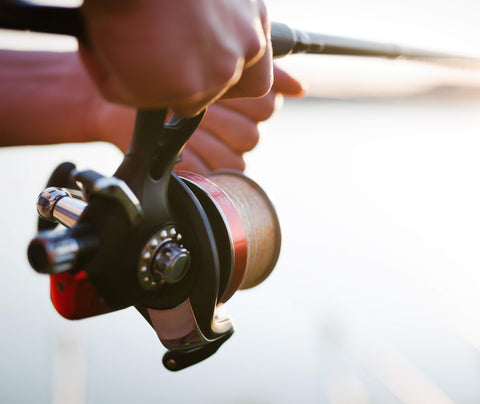Attaching fishing line to your reel is a fairly basic process that is fairly universal regardless of the reel type. There are a few ways to attach it that will suffice, but this process should offer you the best overall results.

The Arbor Knot is your best overall choice for this task, and very easy to tie. It is basically a slip knot with an overhand knot at the tag end drawn tight. This video shows you more precisely.
The main thing to remember is that the spool needs to be gathering up line, so make sure your slip knot isn’t allowing it to spin without grabbing it tight. Often there is a small catch designed to hold it tight as well. As long as it is going onto the reel in a uniform fashion you should be fine.
This knot is suggested for monofilament and fluorocarbon lines. This can be also used for braided superlines, but only if the spool is designed with a non-slip braid-ready spool.
If you’re spooling a medium-sized spinning reel and your style of fishing demands anything that exceeds 12 pounds, using a braid is recommended. If you don't have a braid-ready spool, first lay a bit of monofilament (mono) on the spool as backing. This keeps the braid from slipping on the spool. Then, you can use a Uni to Uni Knot to attach the braid to the mono.

Begin by ensuring all the eyes line up on your rod. Remember to check the direction the reel turns upon cranking it. Ensure you mirror how the two spools begin to unwind. The line should unwind off of one spool in the same direction that’s it winding onto the other.
For the line to be spooled onto the reel more uniformly, match the direction of the reel and line. That memory will enable your line to spool and unspool uniformly.
Or else? Or else you may have some unruly line that bunches up and is apt to create a birdnest if you’re not careful. If you’re unsure, test it by reeling in some and then seeing if it coils up as it comes off the reel again or if it comes off more smoothly.

Remember to open the bail on the reel and keep it open while spooling. If you miss this step you may find yourself starting over. Use a screwdriver or other tool to hold the line spool and allow it to freely spin as the line comes off.
Now slowly start cranking on the reel and make certain the line is gathering onto the reel correctly. You'll want to hold pressure on the line with your free hand if possible. Once you’ve got it going it should be an easy process.

How much should you spool onto your reel? You’ll want to leave it about ⅛” from filling the spool. Any more and it may start coming off the spool on its own. Once you’ve reached a full reel cut it off and attach a leader or snap swivel for your lures.
Need to know more about the type of fishing line you may need? Oh, we've got a blog for that. Also, if you have further questions about stringing your fishing rod, we've got that here as well.
Tying fishing line onto a reel is one of the more basic skills you’ll pick up as you get out there and have fun, make memories and enjoy the water. Tight lines! -WR

